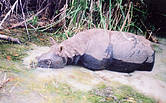
Baby boom for world’s rarest rhino species
Signs of the rhino calves were discovered in Indonesia’s Ujung Kulon National Park by a team of biologists, including park rangers and WWF staff, and local people checking on the rhinos after the recent earthquake on the island of Java. These are the first known births for the Javan rhinos in three years.
“Javan rhinos are probably the rarest large mammal species in the world and they are on the very brink of extinction,” said Arman Malolongan, Director General of Forest Protection and Nature Conservation at Indonesia’s Ministry of Forestry.
“To discover that this population is breeding, and even slowly growing, gives us hope for the species’ future.”
Javan rhinos are the rarest of the world’s five rhino species and are critically endangered. It is estimated that between 28 and 56 Javan rhinos live in Ujung Kulon. The only other known population is in Cat Tien National Park in Vietnam, where no more than eight rhinos are thought to survive.
The team found the first sign of a calf a few weeks ago, with the discovery of a small footprint (about 16–17 cm) along with a larger footprint belonging to the mother. One day after this first discovery, another set of mother and calf footprints of slightly different size was found in a different area. Both signs were estimated to be three days old or less. On the same day, a second team came face-to-face with a mother and female calf. And the following day, the team found a fourth small footprint in a different location.
Because of the distance between the four areas where the discoveries were made and the differences in the size of the footprints, the team concluded they are evidence of four different calves.
“Javan rhinos live deep inside the rainforest and it’s very unusual to catch a glimpse of them,” said Adhi Rahmat Hariyadi, WWF-Indonesia Site Manager in Ujung Kulon National Park.
“Our team was lucky to actually be able to observe a mother and calf in the Ujung Kulon Peninsula while checking camera traps installed in the area.”
WWF and park staff hope to capture photos of the newborns from remote-triggered camera traps used to monitor the rhinos.
With this new evidence that the Javan rhino population in Ujung Kulon is breeding, WWF recommends that the park authorities find ways to reduce the main threats to this rare species, such as habitat and food competition with wild cattle within the park, and invasive vegetation that limits the expansion of the rhinos’ favoured food sources. WWF also calls for the establishment of a second population of Javan rhinos outside the park to protect the species from disease or natural disasters that could wipe out the entire population.

Birds’ Paradise
Parallel to the way to the Chambal Canal, this beautiful place is heaven for birds. Just stop here, turn off your engine and listen the lovely songs of many beautiful birds. Many of the birds here hate people, so you have to wait for their turn. It was too much fog of...
The pink river dolphin
The survey, led by Colombian conservation NGO Fundación Omacha, with support from WWF, the Wildlife Conservation Society, Fundación La Salle and the Whale and Dolphin Conservation Society, counted 33 pink river dolphins and seven gray river dolphins during an expedition through the Ecuadorian Amazon, along the Napo, Lagarto Cocha, Cuyabeno and Yasuni Rivers.
“We are pleased that we have sighted a good number of these vulnerable freshwater species,” said Fundación Omacha Director Fernando Trujillo, “but we are still very concerned about threats that are affecting overall population numbers.”
River pollution, deforestation, indiscriminate capture and incidental fishing are some of the factors affecting the South American river dolphins. Oil exploration is also a factor.
“Aquatic ecosystems are particularly vulnerable to direct and indirect impacts from this activity, mostly because it pollutes the rivers and increases the number of motor-driven vessels,” said Victor Utreras of the Wildlife Conservation Society.
“Dolphins are very sensitive to acoustic pollution and threatened by collisions with fast moving vessels.”
The South American river dolphin survey expedition, which consists of scientists from Colombia, Peru, Ecuador, Bolivia and Venezuela, started in May in the Venezuelan city of Ciudad Bolivar. Following the recent freshwater dolphin survey in Ecuador, another expedition will take place in the Meta River in Colombia in August, followed by two more in Peru and Bolivia in September.
The overall aim of the survey is to establish how many river dolphins there are in the Amazon and Orinoco Rivers and their tributaries.
“Along with estimates of river dolphin populations, we are also gathering as much information on potential threats and conservation status on the species in the areas we visit,” said Saulo Usma, WWF Colombia’s Freshwater Coordinator.
“This information will contribute to the design of management plans and specific conservation actions in the headwaters of the Amazon.”
END NOTES:
• The pink river dolphin (Inia geoffrensis), also known as the boto, is found in lowland fast flowing, white-water rivers, clearwater or blackwater rivers. The species is also present in the largest tributaries, lakes, confluences and seasonally flooded forests. It depends on healthy fish populations for its survival. Historically, the boto has been spared human persecution because of the belief that it has special powers. Today however, it is increasingly viewed by fishermen as an unwanted competitor for fish. The boto can get tangled up in fishing nets, or suffer wounds by colliding with boats. In addition to spotting the pink river dolphin, scientists are also on the look out for the gray river dolphin (Sotalia fluviatilis) — a dolphin species darker and smaller than the boto, with a shorter snout and a distinctive triangular dorsal fin.
For further information:
Maria Ximena Galeano, Press Officer
WWF Colombia
Tel: +57 2 558 2577
Email: mxgaleano@wwf.org.co
